Chapter 1. BP: Gulf Oil Collection Increasing?
Introduction

BP: Gulf Oil Collection Increasing?

Synopsis
In April of 2010, a huge explosion occurred on the Deepwater Horizon, an oil drilling unit in the Gulf of Mexico. The result was the largest oil spill in history.

A massive cleanup ensued, led by BP (the owners of the rig) and government agencies.
Click the Next button to start this activity
1.1 BP: Gulf Oil Collection Increasing?
BP made numerous press updates about the progress of the cleanup. Go to this link http://bp.concerts.com/gom/kentwells_update24052010.htm and watch the video from 4:12- 5:00. Listen carefully to the explanation.
Question
tlZ0rlSu2IbMBPgyVy1KgS1FErwkArOSAE7kbxVeTAFjhJnjTJgpi4BCIP501FuG1wtBF6DF7XYOrn01lSiQ3xG6CvXvPP3p99LjrRCy0OM067RYIPoDiOX6FCdERsj57sy/E576Jj4Ne6mxuL7+2O4j6doRru+zciLDXAfZoksAbopKvy2vWhUNX/TsXkr8A1bRX9n+AET4OMB2naWjA8fDIcjH+JL7AySTkJFXN0dL8XeFc5K9vloft2f9/wXW89FlmkSOHlQvfkkfaAFFLzFHdspN2i/+n0JdcyvfuGMq9qdxb/KCLmSfJieb1cKgupkeliYiEwen0hcUEepdAAHSYZ7YvLdp1ctMDGYZ6bT1hxR1sN6g2PApzpI5005rqEP2r4CosMkKllVcDJMmwsPbQX+8O8VXiF/yIeWRy8iux2wkH1F9mirhm0hciukMxfiSwco+DyP7+tbnMtMed6h8QCB85gf2TJ2Frus8cr6Ty8MG5Cf1rGc9ACqS8kTJNC2el7lQeljMZW5g0GIiYkk+axyBpSxq4UOMDlygYe3cKjgmMIMB5hcs43d45jt5q8UWo8BhPD17+12rssycHLMr+UDkW9mR+yNDvxZww8VoalYTyEfVu14C0r64Xelvts5QJ6c0Y+0=Question
DDn4wSotG7gYxjRAfMlXbp9j4lOOuOlA/gQw9Me57v3igbWpRKwMe7ky/DGkaGFd1.2 BP: Gulf Oil Collection Increasing?
A different view of the same data is provided by Stephen Few (http://www.perceptualedge.com/blog/?p=790).
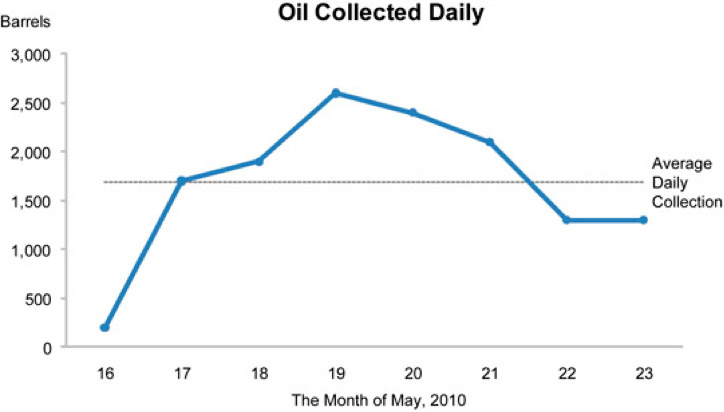
Question
pfD3KRGO2J1ZX2xX4LQuwTRO9pU+jJqSu+eWM3MyqV4BQk255DfSHxVlXcbqinb7wsapZhhbmM5ptg5e2Go8RFUZH68URDhCcSdp0ESoUsZzIn+rQjer8NIz28Gb6obKfUjcxjr0DHN5SRWJeP6Gsh72fOOvlBBDDIiqfPLDrXzymQmvmTwB69A7PD3AnolceWEOWtuwDdgUsCiK6LKQCa3Nhuvq5SV5wmMqINXpyBPHN/PgqZtLe/DPvRL/7OgRdAf3kGUb04ulbqwJ7thrs5fKUlpKYlAccQnlZ1/f18x+4Yt5FAPkfUCyB6ppox47DkcQ2HvskHJmNyOloEa5tJC9M7VgMnmKIyEL3yrvzNqUTU44pmNdUHIXbU90Yc3m770TaiHXY6JfcO5L9VIBZ/pYBnCPo+QDuXtQ0sOoyVGKsjqLH/OvaH2iHh2icCXDynhCE7bzja15cR/TVYZgYmMHkUkG44lHk5F5gczNKL8NirILRNgEWXSJFFkk2kBFutoPnpNthxwe0sSZRYzQgxp5FSP6M+XvOuTDkQfns50x/ED1ZXX+sIFOFzd0MlDv0iCAjwKIKLDfif5PrnL2uqJdnxE+vaP8Hu/WJrZYn3bT3VknnzUerISuffro1GPOBQZYSwV6nBWpLV31gcRLIsyCOweb2dRETovI6EC6zxWSKaQvlvqfAFblv54=1.3 Scaling of Axes
The way in which axes are scaled can dramatically change the appearance of a graph.
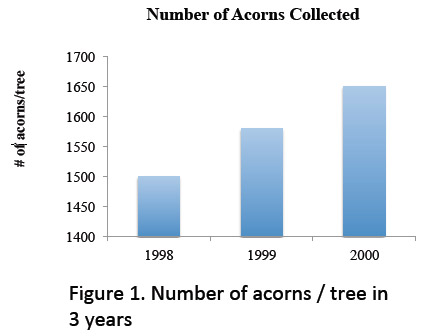
Question
rY7SShNEyWa6i9YpagP6qTMA98jZ7sHp/ROUPsyWhhK5zlcvsOdtaNEn93xhJKDGi8xjIoPy4Ew2pIID8Pf25v4gpUvIaiRO58m+hjtzf6CXECkUJPBOI8ZG5p15rB8PGp60jjgSWRl2T5WKqHoPZVi+y8UOSlE9ds0+MgjjeuyzwnY5mBdwn2Ena7mxkaSScRKBI97FOrbCydgp2Sql8yp6CDIQc4udcbKeggmSw0E=1.4 Scaling of Axes
Now, examine Figure 2.
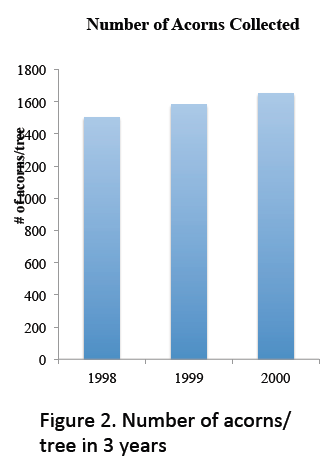
Question
N0WzmgaU96ZkO/yf7VeF98LqGHvG4wFIJ/X8CadPOXnEfBWibksIjJCre1GWqzNN4/E0eCw3YKeRFxg76D+DVlXcYXGne1D8b8zxuZ13XftrUtTuUv7fBQ1MNPRAGNpbbEHL1FYHFze5FHd351Or9PhOmN4wfns/gMr6OOVvGT8j0JsLZBziyfViHuvhOPCj9ucBd3F3nPacXAOoV8tuUttle0xkMrJsgASdUzjn35lyWKyqCuPNQR0WqMYNoCZlfIbN6Q==1.5 Scaling of Axes
Question
x/CKZVShA9jN8emBS6EEiIAlkXgn4h1x4WqXk+uXFK/LYnQwQFyiWa/I/c4ZxvHSmhdSOpY8bp2FVBqLUJb7qikU3JrOtgCuC1MBcr5d4NYLU1hGu3B78FSQxoE/nvS2w81x4PaMu6PFjUWuc7EALRqFF0RnXC24k+yY1GbPOJzpIiZiKQ5AFaoRJL0cjD/OE1JPIezQTDpMuFIhVpmfr25Hl+SJVBl8WHRyJo/rf2aNEeaaB5Tk2KPFdVXZvcpdh8ErVBZWEklQ1r3ijajtPRO4V7Jvef98HHcGExqOVvOcFnsENl2NsWoV0WYg9qEcf6V38TDACJjaAEqKN+kjkUUwpdjh1GFbzMHvfSl4yQH3t5pfxhHzm2Idobb3W7Kmd28gABZKo0+NMwPmnKX+EX6+XsBzCll6TNl2xJ+astT6AzxKXw0FyZ3dGr/NHHhqNf5GGJKPxHPaHb8mM3fM3LQtqymd1jehQGNcYJbUuAo83dA1zSYXhnC4ZoGoXcIqScWWkN60ydBBQuH6rst2iusaQNJ4bPl909U/vw1i0Vl8T+Kjk5IW0zHo7YI8hQm/lmpT5YbJUqxZdpXw2uhdfo1lxHE=A key to making good bar graphs is to begin both the x and y axis at 0. But people often “adjust” values so that a graph will better reflect the message they are trying to communicate.
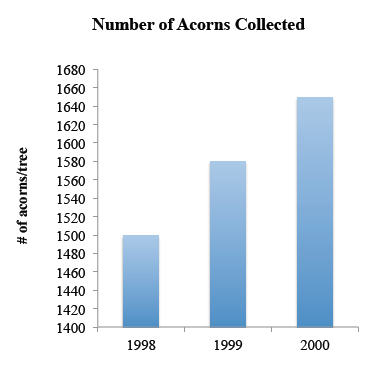
1.6 Scaling of Axes
Another way to change the appearance of the data is to alter the scale of either axis. In Figure 3, the same data are presented as are found in Figures 1 and 2, but the units on the y-axis have been decreased.
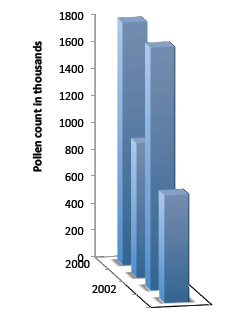
1.7 Dimensional Effects
But look at the same data presented in 2-D. Notice that years 2000 and 2002 actually had the same pollen count. Scientific data is usually presented in 2-D for this reason.
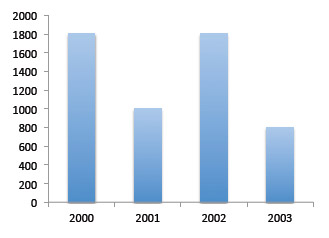
Question
DXrBCU+nvYxSob4H1qe5h/Qz+TRisZTtp8fsfMT+lLflLIG6gztgOrDPkphzZHh3H/n+L9ded+r3U74U2Uqym4cnEjSOMe4MrF6tVM0lA/6G+UsmwlJZXpqdo5LaSSuBVFs1QjVJZ8Tx6lAsn380tWzaEOMZ/0Jj+j7DaG7PamxC6sHzgDp3K8uczYFjBLB/1GkQ5zxlY0OW9v5vheHVpIcZDBw=1.8 Bubble and Pie Graphs
Bubble graphs are often used as a quick visual to give someone a sense of changes in magnitude. For example, look at this example of a graphic depicting the size increase in the battery of the new iPad (http://gizmodo.com/5893738/holy-fck-the-new-ipad-has-a-gigantic-70+percent-larger-battery).

Question
oAV8jra6zOOhsQQYp33i0POaJqk/9DyxM+3jr16lwaAg4v1gxt6hD4eJh4S8QWj6szwlR/fCo4tjv0aIf52YuzLtmVNfhVkeE5c1BaeXa7dYoVvvzUGjIXigO73cryC4946oUAmUcY8iLRsPBqwyCDKOFFDzoq2NjA2qIk9fT5PopzUPV/0AJ4AUa4bOPxsYhZ0vTMmYPO70jVAj10p2RWNcXxcGi24h3N6xJkLIHp8aAxPanM5zZRSCMfCzZDsS522jw8EMSphSbMdwJbUhbjqAjGrxeS/HgQ2V2h/o7Z5GaaCRL7FiYrOEnQHivVwck8aTl1+8fiktguh3mLszRiTAzagvYIhVRIruNpvwa6t91zTllb+nMGy5SjVaaOaiRNPASzzgK7P/mYTuhVx2C8jZ9qa50sdQ/Ibpgo0m/UhlTVYRojXjpv4CognH8kYRqL9iKmyrdLkPwax4OP6DXbzx2tDfHhhl+LkR6FJtQgGkicxzV/lMaxyI97JT0mvNeVoqIq9E9d7XF+x4uehw21ThHLlw4nr6fwFXd0uiPEzctlyn15gyQ0YHYb31327NsO4kTuSooE0cxbE+qX7rmPR5zum4S+KKOxrFqoJPcWY=1.9 Bubble and Pie Graphs
A more accurate representation of the battery size comparison between the old and new iPad batteries.

Another Example: The size of the bubbles in the following graphic represent revenue of major airlines. Questions to ask yourself:
Are the bubbles proportionate? Compare British Airways and Air France/KLM.
Is the number of passengers accounted for? If you did this, what would the bubbles for the same revenue look like in China (population 2 billion) vs. Europe (population 50 million)?
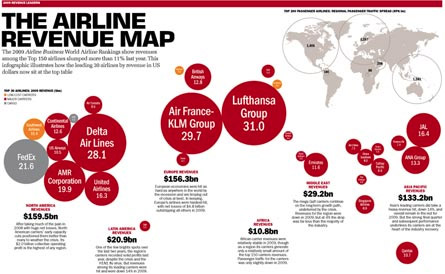
1.10 Bubble and Pie Graphs

Question
LK2Dvc+a8CejMrZz/6cphwWJqtfLTwU0gCgODv00ely8+O2MgHSf3s0rZOTLqa8TVuP0w800NUulDli1/LsSDH7X8OsKWoLWOGrPJg597xHhAhESVp244KOm5hiQg6jyMXrfvyUPHIHozesBdHQompRf4VkcFJZpqaTV1EMtf9YYVK2XkWMGoNJWyHHd14U26TDH/t8k/hOFAjW9li9bxUTUyrfl0d9QNdKc4Wed6Yf1hm/sLAfoEuzPuyAswMLMSbybLyFLTWL5hU7WHCLnoYgomjzYGIJ7393XZ8gBB2UiTP65DvMcAPv5iwTGgBIadf6npopaZ2fOs3NC7NcLrb90hXVOKM9Ljmia6XwlstGRsSSTldYZV6fPXsBguqWNyXJsEeSDIWw=1.11 Pie Charts
Pie charts, especially those that represent percentages, should add up to 100. Compare the following graphs:
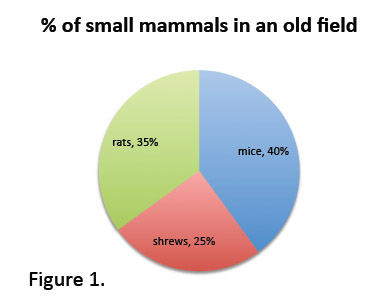
1.12 Pie Charts
A real-life example—how did the cartographer come up with these figures?

1.13 Using Snippets of Long-term Data
Another way that data is often misrepresented is to overemphasize a small piece of a larger data set.
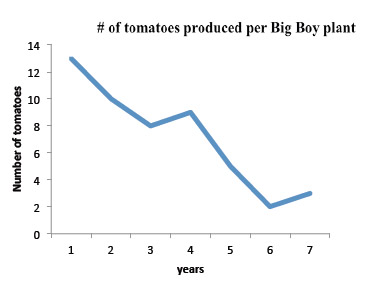
Question
dkIgdrqdoM8/wZvXm5c3euRGQx/4MSiuXpKqS0rGqZrnWky9yfQhMw1iVWfDcMLwW9aqbpgY0XTSVohC6pusl5SIfs7MMIsjmZCPXUJMx/UPjJSoXwty9jLcfV9txs5J50XzWSl5l6YTOGGwY+MoPGMxdgGFpaM8QtZTzvh/60c78Wp/nHQ7jt4hztsRUPuO0v4sodawpuGBslUELN3Xupba8R8HFjJYpoJp5l0UItD7UJ6f4jQBGFu4LttN6snZfX3b+vKh2Rs=1.14 Using Snippets of Long-term Data
The following graph presents the same data, but includes data for all possible years.
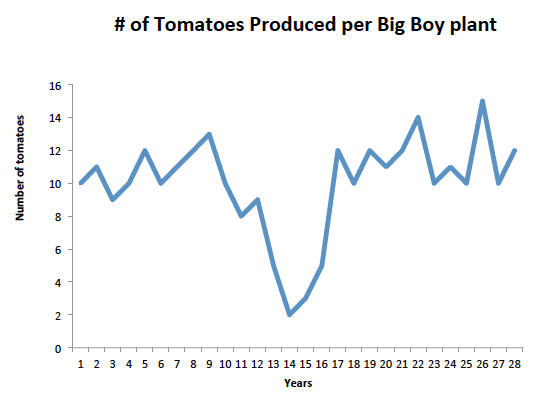
Question
VeLVgHkCJ28xucZhxuC0yngsw/rnel9AMY07t2PMs3jiiH9dhENNc/IwLJYx8D2zk7VJrWfAJ9B2NIduxH+Ff1Y1QI8GvOuL7UULWBtiKXG+IngPVxQdmhwi7BC0Xd8oZTN6xiBIkkcSYQCHnVWm4snNpk+5hPmoITfGHgqr/QwM4SsbGk+zC2Xe335OqMkEKX7LeKGVFJWEqEOrAVMzq3b1DtloD6nCoJ2QVYCd+uja7mZvxj7L2fTKD2Lp08M89m1hi6H6Bpm8Q/AGok9TrweNp5eObt2RRhBWaLqKod29HiA6cdskb6tTBeUzA+TQ4QE1bzk7BP9cb3YSbLAsDK2XjwVc3OPG8E3qdw==1.15 Pie Charts
This type of misrepresentation is common in climate science reporting, as illustrated here. Some authors use examples of decade-long cooling trends as evidence that climate change isn't real, but when you look at all years combined, those patterns do not persist.

1.16 Lack of Comparison or Reference
Finally, data are often presented with a lack of reference. For example, in a column in Newsweek (April 9, 2010), George Will wrote the following:
“Wind power involves gargantuan ‘energy sprawl.'" To produce 20 percent of America's power by wind, which the Obama administration dreamily proposes, would require 186,000 tall turbines -- 40 stories tall, their flashing lights can be seen for 20 miles -- covering an area the size of West Virginia. The amount of electricity that would be produced by wind turbines extending the entire 2,178 miles of the Appalachian Trail can be produced by four reactors occupying four square miles of land. And birds beware: the American Bird Conservancy estimates that the existing 25,000 turbines kill between 75,000 and 275,000 birds a year. Imagine the toll that 186,000 turbines would take.”
http://student.ccbcmd.edu/~abeiderm/math111/misleading%20data.htm
1.17 Lack of Comparison or Reference
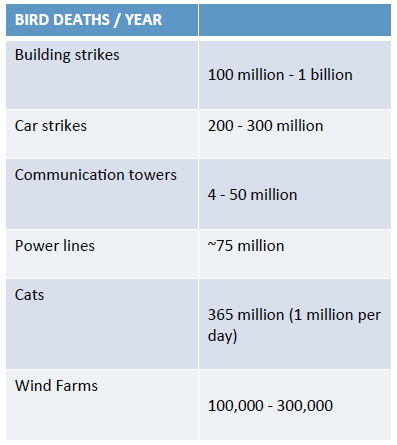
Question
tEU7xHeFni5DKhAAY4D8Y840WHEfB0Gs6icLm8xKNQIKupiYCZ5IaGXKtSOWo4wIiIG5evgOWXz7xrbPQhfZVRHxictqjruY2yhZfmovDqSK7ZmAlD03U2Gj4+psIHMkLLaIWvP3idduWXeIhMlJszMvUEsdewLdnslTL7wnpOAj35dFq1iAUQ0n39a536X7heYcpH5+2bn2rh26A0dUil7aZTbTpgAegpMLY3yy0Nn5y1afuD8XyiH+1p/7atHT5KqGzco+hSLWDLML+l66R4YBE2cGnwcLfU87ZV87fPNmz3krJbA278caY8GKpXHg/R2RgAnpRHCitHcQyMTvp9VTKBzvicH0cgaYCEAtYMCpqWFNK00JYtyKJjoX7g5Rm5v75lTXblAUkLCP4iLyFIKj2+n38TsUgQL6JpyAFIZ2ZeicHhUTGpk8MQ5FjTqVdXzGpKrfBhfqN9TXzyW57WZ8ru7N3QGqHr/nyKiI0Ze2YWUmDnDOrhuUUKwQJZDPMq6dE7Hcp60eiOfFBqO5NGfv6VaNgcBELVGG8Djjlt1yPeckT1uyJ9p3ahGodn+BFrvExm+ka2ihexkkURpPBjATPFJ2QPEUOUr8JaZiBQw=Question
73Q2n83p/mo34bH+9MQc8vUm36+1jypvQxIdZRLzzb7YNQ8AHnl5rXH/D4B+NzE135tADAA+9N2nH5Fg08Ya7HR8zV3HbqdHV6PQBl7q87RDyE0YuuIaKejdmR2sGh6u/Jb02mOGOgWAfvm87ROghlkpcBzcYjGmtT5v1B5MDjfawhQs5M9V71qmD1FClcXC86dmND1g8lO0WQXqr/41SMlPB9QPpBVfEfetrJatKqs8j+c4j+TR7a/nBE5bsmlWTn5NNt2jVmTCNQZOWJsSE19SnASc6Jx3SymQxHC6CgH1tJTPquYWw5XNIozRqQjjCpJ+KhdCm/mdxEB9hcEQ1CGkbcST7sgL1.18 Analyze Data Carefully
In this tutorial, you've examined examples of misleading data and graphs. These examples include verbal misrepresentation, improper scaling of axes, improper use of 3-D, improper proportional scaling, pie charts than don't add up to 100%, picking out small pieces of data from a larger database, and not providing the viewer with a reference point.
A final caution—data can be represented in many ways and what you see may not be the best way.
1.19 Analyze Data Carefully
Let's return to the BP oil spill data. BP emphasized how much oil they were recovering on a daily basis, but they did not show a simultaneous representation of what was leaking per day. When you graph these data, you get the following:

1.20 Analyze Data Carefully
Question
d/79zIPnaDGtLkRoF1KUYizDQE7CTxTRaylyeyxVK1drPZXYlMtX/MdAhPZC8VzLgM5BJkAmxP/CYZIMHSTaEb5BCNeCvMeeemahhiWJDh0LpkCs/hYua0C28ljTTSZYQRb0kv7jRKVuYOAgyzGVcNw6jo3aV9bVHFcrCnzbYaIGld29Q5/Kj/jFrKS0hy9cQhPCmrvnSJWTuBuREZ2KhXnoUgofKl+5C5w3VwdFnUFOzc8UEShyyxZnUXn8ejuf2/IWQOc1p4WGj4cJOsPWpiVouxzCaOKjpXMPQ89GBEwaK+e6mudJ62GBJQdLPj5EtgRxfQvLo8AJkvysYnIHa04xniyjVTXcEEWBbnebf/HDHx7/LjHuzTsa/98McsfM/GxbbT7MPvIuplQB2XaD1P3XYsmr6s8TYeDX7+OTlZvAohMPyR/t/4OwoTe12bZgGspHeb1argrg2H2f8+r6T3HRvLKRmM6BAmd5x877H2ZZwXLMpGsS9QI5CJz08TkvckZyYB075JRvr6MaO7hDDpINtLH0IaKd0LVgCPRSopL2iTdBz+i9Tpj0F9mmi79FatyfLCTYHoDbmm0HNxbJRLgJFz1BRM4F40sXEm1B7frL0ryie06RgK9q/Ct0hL9hBi6QIBNqRBf6GkbZvV5xug==1.21 Activity Completed!
Activity results are being submitted...